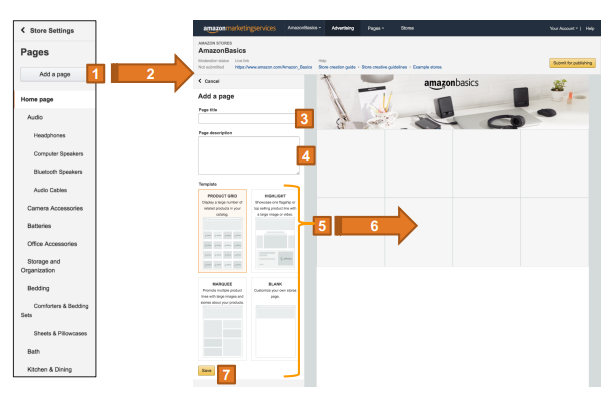Amazon gives brands a powerful way to establish who they are and show customers a broader selection of products by offering a free Amazon Stores page. These pages serve as your storefront on Amazon and let users click on your company’s name and be transported to a page you design, with products you choose, and a chance for compelling CTAs.
It’s a powerful tool to keep visitors looking at your products on Amazon.
Content:
Amazon Stores explained
Amazon Store pages are free, premium content that vendors like you can use to create a curated experience. The goal is to give you a way to drive more page views and traffic. Also, building out a store also improves your organic search ranking on Amazon.
While most brands right now have a single Store page, you can set up multiple to provide customers with a “Home” page, categories, and individual products. Each page has a tile layout that you can adjust and fill with rich media and content, making it a prime place to build your brand, highlight products, and land a sale.

Stores are relatively new, so many companies have yet to build their pages. That can give you a leg up on the competition, especially if you get the branding and content right from the start.
How to get the most out of your branded Amazon Store
Let’s dive into some Store best practices and benefits, including building product consistency to generate interest, their ability to improve trust, and getting more of your products in front of customers.
Match layouts with your website and brand colors
Amazon offers you a lot of creative freedom when it comes to your Store page. There’s a temptation to go wild but try to resist it. Think of this Store more as a physical storefront. You want to keep things clear and organized, making it possible for people to shop easily. Most importantly, you want to create a look and feel for your brand.
If you’ve got neon on the packaging and wild fonts, use them! Are you trying to sell luxury goods? Keep it elegant, dark, and inviting. Use the best practices for your industry and any existing colors and photos from your regular website to build continuity between the two. Match your existing brand so that people trust that the Store page is legitimately yours.
The obvious place to start is making your logo and tagline the same, but take it a step further and create a clear visual style for color combinations, images, and product info. The predetermined layout and functions of the tiles make this easy, thankfully. You can group items, repeat pictures, and often utilize assets you’ve already created for your website or ad campaigns.

Take a look at this branded Amazon Store from Smartpetlove:

The color scheme is standard, nothing fancy in the backgrounds, and images are often clips from product descriptions and Amazon ads. However, the similar feel of their images, the grouping of products, and the use of negative space tell the story they want for their featured Snuggle Puppy line.
Highlight reviews throughout
Reviews help boost sales in the eCommerce world. People read and believe reviews more than your marketing, but you can leverage those trusted reviews directly on your page as a marketing element.
Instead of a photo or text tile that explains your point of view, provide content and words from fans. Take reviews from your product pages and overlay them on an image. Grab a screenshot of a customer’s social post and incorporate it. Build in what people say to make a valuable case for buying from you. This combination allows you to make your case and offer proof that visitors find believable.
Your goal here is to be honest, sticking to legitimate reviews, and using direct quotes from your customers or other sources. Amazon moderates Store pages, approving your initial designs and when you make significant updates. A brief review of store pages shows that Amazon is willing to work with quotes, awards, and other acclaims when they’re sourced and reasonable.
R+Co has a smart page design for quotes and awards. Each lists the source and what they said — such as the text “The Best Pro Dry Shampoo” next to a quote and award image from Glamour — and clicking through takes you right to the product mentioned.

While you’re using someone else’s words or images, it is still your Store page. Ensure that the branding feels like you. Building consistency makes it easier for the shopper, leading us to a more significant point about your store.
Use tiles consistently
Branding requires consistency. Because Amazon offers multiple pages on your store, use tile position and content types to create a consistent look and feel. Set a style and pattern across your product lines, categories, or however you want to highlight them. If you build a flow the visitor recognizes, they’ll quickly understand your intent, such as if a photo shows a specific product or a series.
Vitamix does this well by maintaining consistency across tiles, background and photo colors, text and typography, and placement. The repetition creates an almost immediate understanding of its products and their use.

Having a standard pattern also helps you highlight specific products by making them stand out when they differ. For pages that generally stick to light images and neutral colors, a bold photo with a dark background or inverting your text and background colors will immediately catch the eye. You can naturally direct people to what you want to highlight, perfect for those best-selling products.
Incorporate video
Amazon Stores support video tiles and background video tiles, allowing you to set the tone and highlight products in a few ways. In a brief look at leading brands and smaller stores, video usage is mixed, and having professional-quality content could be an effective way to set yourself apart.
Stick to short, professional clips designed and filmed for a specific purpose. Keep videos and interaction simple to allow customers to engage without overwhelming them. Amazon has requirements to help ensure you’ve got a nice-looking video.
Here’s how each video option performs on the site:
- Background video tiles: These are silent videos that automatically play and repeat as someone browses your store pages. They don’t allow the visitor to control the video but shouldn’t get in the way. Use these videos to set the tone of your store and brand. Consider complementary brand colors and smooth action. You don’t want a lot of dynamic activity or big jumps and cuts here because you don’t want to take their eyes off your products.
- Video tiles: Video tiles can be related to your entire store or a specific product. Shoppers will see these elements and be able to click on them to watch the video. You can add sound, and the visitor will be able to adjust the volume for their playback. They’re a compelling way to highlight products and why people love them. Treat these as highly visual ad units.
WOW Sports has a strong video compilation of its products and audience enjoying them on its Store page.

You should know a few things about video tiles. First, they’re mobile-friendly. Second, on desktop, they’ll play in the tile with the option for the user to go full screen while they play in full screen on mobile. And finally, you need a cover image to display when the video isn’t playing. That’s standard, but the format might not be familiar for your audience. Add a play button on top of any image to ensure they know to click and watch.
If you’re new to video creation, consider turning a brief product slideshow into a video. The page design allows you to use video tiles throughout, so even just a slideshow below the fold can be a nice final pitch to motivate someone to make a purchase.
Build what you can duplicate
Let’s finish with one final piece of advice about branding for your Amazon Store and your broader eCommerce portfolio. Stick to what your team understands and can duplicate elsewhere. This can mean mirroring the style and layout, repeating images on your website and Stores page, and ensuring that you always use the same product category names.
If you visit the Vitamix website directly, you’ll see a design that looks a lot like its two-column Amazon Store page.

The image for its Explorian series of blenders is the same, just cropped differently. So, if you go from their Amazon page to the company’s website because you want to learn more about the Explorian, you can find it quickly and easily. You, as the visitor, have a lot less work to find exactly what you’re considering.
Uniformity across the stores gives your customers visual cues to reduce barriers during their shopping. Customers will understand that they’ve landed on the right page when there is visual consistency. Mirroring elements like the product grid also help reinforce your sales messages. A customer who finds you on Amazon and Googles your company may visit your site. If they see consistent colors, images, and products, they’ll give more weight to your products and reviews.
And finally, keeping these elements consistent makes it easier on your marketing and design teams. They can work and build campaigns and content for you and then only need to adjust it for each medium instead of always creating something new. In the world of eCommerce, improving speed translates to an improved ability to pitch a new product, offer a discount, and make a sale.
Stores are a powerful place to sell
An Amazon Store page gives brands a new place to highlight products, share reviews, and entice visitors. With the ability to curate your catalog and create experiences across multiple pages, you can use them effectively for visitors already on Amazon and as landing pages for outside ad campaigns.
Thankfully, Amazon offers a powerful editing tool to make it easy to add a wide range of content and information. You just need to determine your best sales strategy and start building.







